Featured Application
This review underlines the pro and cons of recent research aiming to counteract the growth of biodeteriogen microorganisms on stone cultural heritage. Ionic liquids, a special class of salts, are proposed as potential biocides engineered by Safe by Design concepts.
Abstract
This review offers an overview of the most recent research activities on counteracting the biodeterioration process of stone monuments, underlining all those aspects regarding eventual procedural drawbacks and compliance with sustainable criteria. For this purpose, the definition of “green conservation of cultural heritage” has been proposed. Its basics have been utilized in the text to highlight the issues arising from the most common conservative procedures as well as guidelines for the development of innovative technologies. The review then deals with the most innovative antimicrobial approaches, among which nano- and bio-technologies play a main role. Ionic liquids are a special class of salts, which can be prepared by applying Safe by Design concepts, to meet the Green Conservation criteria.
1. Introduction
The major challenge for researchers involved in the conservation of Cultural Heritage (CH) regards the development of innovative specific protocols that match sustainability criteria. This involves concepts such as nondestructive and/or reversible procedures, and safety for the environment and for restorers [1]. For these reasons, we refer to these strategies as “green conservation”.
In the recent fourth conference of YOCOCU (Youth in Conservation of Cultural Heritage) held in Portugal in 2019. (http://artes.porto.ucp.pt/en/greenconservation2019), the attendees tried to clarify the meaning of Green in the context of CH Conservation (Andrea Macchia personal communication).
The acronym SMART summarizes the clarification.
Sustainability: conservation as an engine of local development, with the cultural heritage linked to the aspects of the local context in which it is found.
Management: planning conservation from restoration into the present and future, and accounting for the health of the operators and environment.
Actors: people including tourists, students, businesses, and such heritage professionals as museum employees and archeologists.
Risks: resilience, loss of economic resources, loss of integrated and specific skills.
Tools: innovative materials and methods.
From this, a new definition of green conservation of cultural heritage is given as: all the eco-sustainable practices to be used in the conservation and restoration of cultural heritage assets, as alternatives to traditional products and methods which are often toxic and harmful for the users and the environment. This definition includes the term of sustainable conservation of cultural heritage linked to environmental and socio-economical (green economy) aspects of the subject, to tourism development, to sustainable chemistry, and to conservation planning.
2. Biodeterioration
Biodeterioration of CH assets is a well-known issue that needs to be faced with methodologies with two aims. First, to correctly comprehend the causes leading to the uncontrolled growth of macro and/or microorganisms (diagnosis). Second, to develop appropriate methodologies to slow down or eliminate the unwanted biological growth (therapy).
One factor that should be considered dealing with biodeterioration as a consequence of the biocolonization process (biofilm formation) is the so-called bioreceptivity of a material. This term was first used by Guillitte [2] to define the ability of a given material to be colonized by living organisms. This depends on several parameters such as material composition, the status of conservation, eventual surface treatments as well as the environmental conditions in which the artifact is placed. Determining the bioreceptivity is an important premise for the development of any sustainable conservation procedure as it highlights the relationships between the surface, the specific environment, and the organisms that thrive in it. A community of (micro)organisms irreversibly attached to a surface and encased in an extracellular polymeric matrix (EPS) (biofilm) possesses features such as high resistance to environmental stress and treatments. It is also referred to as biological patinas or lichenic crusts [3,4].
3. How to Treat and Protect Cultural Heritage Assets against Biodeteriogens?
According to Pinna [1] and Caneva [5], to control biological colonization, indirect and direct methods may be applied. The choice is dependent on various factors, which include the biodeteriogen types and their degree of extension, and the nature and status of conservation of the artefact, as first suggested by the Italian Committee [6].
Indirect methods are intended to modify or limit the effects of some harmful environmental factors (pH, RH, T, light, etc.), which directly affect the manufact, contributing to the microorganisms growth (Figure 1).
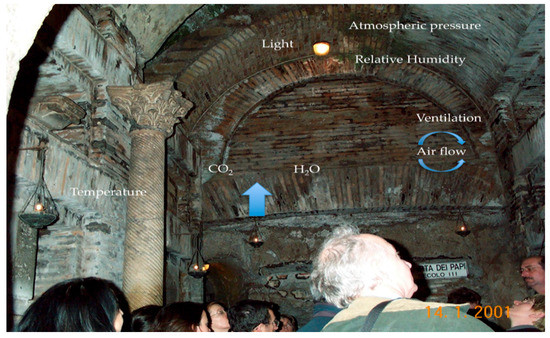
Figure 1.
Example of physicochemical parameters affecting an indoor environment. The presence of visitors requires lights and produces an increase of temperature, relative humidity, and release of CO2, dramatically changing the delicate equilibrium of these environments. The image shows the Crypt of Popes in St. Callistus Catacombs, Rome, Italy, during the CATS project (photo, C. Urzì).
As these do not act directly on the object, they may be considered fully green in terms of conservation. They are suitable for indoor interventions, while they are difficult to adopt in outdoor (Figure 2). It is pleonastic to add that the control of environmental factors is almost unachievable for outdoor cultural heritage assets, since these may cover a large area and, hence, be subjected to climate changes and pollution.
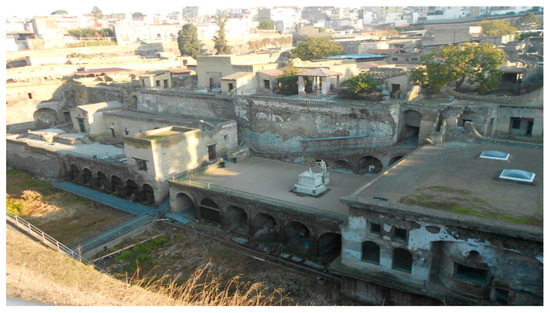
Figure 2.
Example of outdoor archeological area. Remains of the antique Roman town of Ercolano (Naples, Italy). In general, outdoor environmental parameters such as sun irradiation, rain, raising humidity, wind, etc. can only be partially controlled due to the different exposition and the extension of the area. Indirect methods aim to keep environmental parameters in a range of acceptability. Image taken during the project POR Calabria FESR, project ‘‘NANOPROTECH’’ (NANO PROtection Technology for Cultural Heritage, J24E07000380005). (photo, C. Urzì).
Indirect methods of changing harmful environmental factors have similar limitations in submerged conditions (Figure 3), as artifacts are subjected to continuous contacts with fresh or seawater, wave currents, and seafloor nature (rock or sand) [7,8,9].
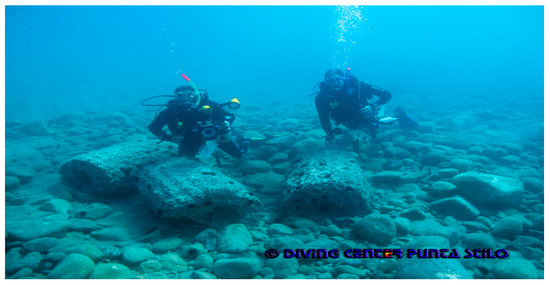
Figure 3.
An example of submerged archeological items lying on the seafloor subjected to several underwater environmental factors such as sea current and the nature of the seabed. Biodeterioration is mainly due to the activity of micro- and macro-foulers depending on the position of the items (Photo, Alfina and Mario Tassone, Diving Center Punta Stilo, Calabria, Italy).
In order to control the growth of organisms in most conservation procedures, the use of direct methods (mechanical, physical, chemical, and biological) is the only solution. In this scenario, whatever method is chosen, any intervention has to be carefully planned in order to reduce the risks of unwanted recolonization. To prevent this drawback, a multistep approach, which takes into account the whole of the factors influencing medium and/or long-term conservation, has to be considered.
Direct methods, acting on the material’s surface, are potentially harmful to the artifact. For this, it is important to be aware of the advantages/disadvantages that the different methods entail.
3.1. Physical Methods
Monochromatic visible light [10] is a very safe, useful, and simple method to reduce or prevent the growth of photosynthetic microflora. The most used wavelengths are blue (λ 470–490 nm), green (λ 500–530 nm), and red (λ 680–700 nm) (Figure 4). If the intent is to block the photosynthetic process, it has to be considered that most of these microorganisms also have accessory pigments. Removal of these may require different wavelengths. In addition, they are ineffective against other kinds of microorganisms, unless photosensitizers (e.g., erythrosine-ERY) are applied [1]. In some cases, those that survive may grow on organic debris from dead cells that are left behind [5,11].
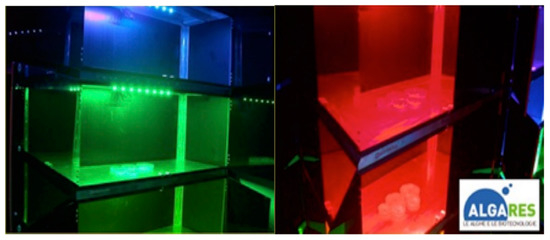
Figure 4.
Experimental chamber used to assess the effectiveness of monochromatic wavelength against photosynthetic biodeteriogens (photo, L.Bruno, University Tor Vergata, Rome, Italy).
UV irradiation, especially UV-C (λ 254 nm) will kill most indoor colonizing microorganisms and are especially used in natural caves and hypogea [12,13,14] and show caves [15]. They are easy to handle, but some preliminary tests need to be performed to establish the distance of lamps and duration of treatment. As their target is DNA, they need to be carefully used (for example, they cannot be left on during tourists’ visits), and any damage to the organic component and pigments should be considered.
Thermal treatments (microwave, heat irradiation, heat shock treatment) are considered an ecologically safe alternative to traditional conservation methods [16,17,18,19]. Thanks to their low-interaction with the substrate and penetration depth, they are safe for the cultural asset, for operators, and the environment. Further, they are effective against lichens and bryophytes and partially on green algae, but they do not have any effect on most of the environmental bacteria and some black fungi [1]. Some side effects, such as the possible diffusion of water into the substrate and/or the production of the organic debris of dead cells, which are readily used as a carbon source by other microorganisms (see above), have also been reported.
3.2. Chemical Methods
Chemical methods bring up other issues. It has to be considered that the products utilized in CH restoration processes were usually created to be utilized in different fields and, in the past, indiscriminately applied on different substrates and not contextualized in a whole restorative project. Most of them were pesticides or herbicides normally used in agriculture [20]. The application has to take into account the possible effects on the substrate. The low cost of the products is also a consideration.
The European Community directive [21] has introduced significant restrictions on the use of chemical biocides based on their potential harm for users and other environmental issues.
4. Concept of Biocides and Antifouling Products
The following definitions are given to better clarify the procedural characteristics that have to be applied to counteract biodeteriogens.
Biocide: according to European legislation, a biocide is defined as “a chemical substance or microorganism intended to destroy, deter, render harmless, or exert a controlling effect on any harmful organism” [21]. As far as CH artifacts are concerned, the term biocide refers to chemicals/formulations or microorganisms that kill any biodeteriogen organisms, usually organized to form a biofilm, that colonize a monument’s surface.
Antifouling defines the ability of specifically designed material coatings to remove or prevent biofouling by any number of organisms on wet surfaces [22].
5. Choice of Suitable Chemical Methods
As reported by Mascalchi et al. [19], although the treatment of biodeteriogens is a part of common restoration practice, the development of efficient protocols still represents a challenge for restorers.
There are two ways to counteract biodeteriogens. The first one is the removal of the already existing biomass. This is usually performed by applications of biocides, which have to fulfill a series of requirements, such as being effective against the specific microorganisms. In this case, conventional biocides (par. 7) are still the best products to be used because they are effective against a broad spectrum of organisms, are not harmful to the treated item, can be easily removed, and after cleaning, do not show any chemical or aesthetic interference with the stone surface.
The second is to prevent recolonization. According to the current guidelines for conservation, after cleaning, prevention procedures have to be planned in order to avoid a new recolonization and/or to slow down the growth rate of biofilms for a time longer than a bare surface [23,24,25]. This effect can be reached by the application of coating products that generally combine, among others, consolidants, hydro repellents, and surfactants [24,25].
Two major antibiofilm (or antifouling) coating approaches are used. The first strategy involves the use of chemically active antimicrobial coatings. The second consists in the inhibition of organism settlement on the surface or in the release of settled organisms without involving chemical reactions [26,27,28,29,30,31]. Fouling-release systems have been particularly used to counter marine biocolonization [32].
6. Biologically-Derived Biocides
There is an increasing interest in the use of natural or biologically derived products that can act as biocides for cultural heritage purposes [33,34].
They may have different origins, including:
- microbial by-products such as zoosteric acid, capsaicin, extracellular enzymes, hydrolases, usnic acid, parietin, or bacterial extract (e.g., Bacillus) [34];
- whole microorganisms against microorganisms [11,35];
- plant extracts such as essential oils [33,36,37], alone or embedded in sol/gel matrix to enhance their performance (Urzì, unpublished data).
The practical application of whole or extracts of microorganisms is quite difficult, as these are hard to control. Risk assessment protocols are still missing [38].
The natural origin of plant extracts as biocides limits their outdoor application. Indoors or in hypogean environments, they have been successfully used to some extent [33]. However, as reported by Fidanza and Caneva, there is a lack of adequate information as to specific efficacy of biodeteriogens at low doses, the durability of the treatment, or eventual interference with material substrates [39].
7. Conventional Biocides
Although many biocides and application techniques have recently been developed, formulations containing quaternary ammonium compounds (QACs) are still widely used in CH stone conservation. QACs are used alone or in formulations with organic compounds that increase efficiency and range of action, often with lengthened stability. In fact, Preventol R180 (CTS), Rocima™ 103 (CTS), and Biotin R (CTS) still remain the chemical compounds most used by restorers and conservators in Italy [40]. Although some ingredients of these formulates are currently considered toxic, they are applied at low concentrations, which do not create significant risks for humans or the environment (Table 1).

Table 1.
List of most common biocides used in Italy.
Field experiments have recently been reported by Mascalchi et al. [19]; the authors compared the efficacy and duration of three common conservation methods. Simple mechanical removal of biodeteriorants allowed the rapid recolonization of stone. The use of Rocima™ 103 and microwave treatment produced a short term comparable effect for 15 months; the biocide was active for 5 years.
In a recent paper [41], treatment of a wall in the archeological site of Ercolano with Biotin R, (CTS, Italy), (5% in ethyl alcohol), alone or combined with Titania (TiO2 and Ag-TiO2), produced a comparable efficacy after 8 months.
8. New Technologies
When synthesizing new materials with biocidal activity, a green approach, and ecosustainability considerations should be a part of the design, synthesis, and selection of renewable feedstocks or raw materials, and degradation planning, with the subjection of the standards of LCA (Life Cycle Assessment) [42].
Many scientists, aware of the importance of safeguarding cultural heritage, have been transferring their skills to CH purposes by providing innovative solutions and green alternatives to old procedures. Concepts such as Safe by Design structural/functional relationships are being used in the development of innovative products and formulations for specific cleaning, preservation, and repair tasks. Bio- and nanotechnologies are significant contributions in this context.
8.1. Nanoparticles
Nanotechnologies contribute in several ways to the development of innovative methodologies for CH conservation [43]. In particular, new strategies based on nanoparticles have provided some promising alternatives, even as biocides, in the consolidation and protection of damaged CH materials.
Due to their large variety and multifunctional addressing (mechanical, hydrophobic, biocides), nanoparticles (NPs), such as SiO2, ZnO, TiO2, Mg(OH)2, Ca(OH)2, ZrO2, TiO2, Ag, etc., in suspension, combined with appropriate resins or as precursor formulations, have been widely applied in stone material restoration [44,45,46]. Featuring good penetration properties, NPs significantly contribute to the consolidative/protective processes of the substrate.
By using proper strategies, for example, the combination with low surface energy polymer matrices, nanoparticles have demonstrated high capabilities in producing biomimetic micro/nanostructured surfaces on a variety of stone substrates with controlled wettability and roughness [47,48,49]. For this, NPs are useful as alternatives to synthetic organic polymers for restorations.
Among NPs, semiconductor TiO2 photocatalysts have played the main role. TiO2-based materials are currently used as self-cleaning and antibacterial coatings. Their application is limited because near-ultraviolet irradiation is required for photocatalytic activation. TiO2 doping or formation of heterostructures produce useful means to access to VIS-light driven reactions [45].
Although very promising, the use of nanomaterials and nanotechnologies in the field of CH conservation, over time, has raised serious concerns both in terms of human health and environmental risks, as well as in terms of efficiencies against microorganisms, and long-term effects on the material [50,51].
8.2. Ionic Liquids
In spite of the research to find new and sustainable materials and solutions for the restoration of CH stones, very little attention has been paid to ionic liquids (ILs). In the last two decades, this class of functional and multifunctional materials has become a “major subject of study for modern chemistry due to their high potential of applications in many industrial fields” [52,53].
ILs, in brief, are low melting point organic salts which exhibit a variety of tunable properties such as low vapor pressure, high thermal and chemical stability, recyclability, good electrical conductivity, and wide electrochemical range. They are largely used as alternative “green” solvents for conventional organic media (VOCs) in chemical synthesis, catalysis, separation processes, biomass processing, electrochemistry, and nano- and biotechnologies [54].
The chemical versatility of ILs stems from their ionic nature, which allows a synthetic control on their physicochemical and biological properties and functions through appropriate choice of the anion/cation couple, creating theoretically infinite possibilities. By anchoring to chosen substrates such as polymer networks, silica substrates, and nanosystems, ILs based materials can be built with specific thermal properties, mechanical stability, catalytic functions, and even new functions [55,56,57].
The majority of ILs are based on nitrogen or phosphorus cations (imidazolium, ammonium, piperidinium, phosphonium, etc.) (Figure 5a). The anions, which usually are employed as modulating agents of overall ILs properties (hydrophobicity, viscosity, etc.), may consist of simple halides (Cl−, Br−, I−), and organic and inorganic species (Figure 5b). Their widespread use has posed serious environmental concerns. Numerous studies have been carried out to establish ILs toxicity and biodegradability as functions of the cation and/or anion species [58]. The green credentials of ILs have been revised, giving rise to the so called “ILs of third generation” based on naturally occurring and/or biodegradable ions (for example, cholinium, morpholinium, aminoacids, drugs ions, etc.), which may have intrinsic biological and pharmaceutical activities [59,60,61].
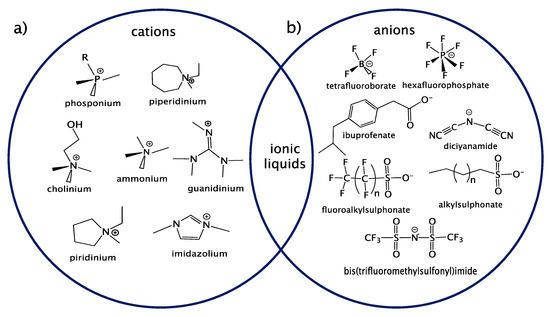
Figure 5.
Representation of common classes of (a) cations and (b) anions, respectively, used as IL constituents.
IL surface activity has gained much attention. Surface active ionic liquids (SAILs) have been proposed, among others, as an intriguing and varied source of novel ionic surfactants, with a high impact in colloidal/surface/nano-science and biotechnology [62,63].
Due to their structural analogies with conventional amphiphilic quaternary ammonium (QACs) species, SAILs have an intense antimicrobial activity [64,65,66]. Their bioactivity is mainly correlated to their lipophilicity/hydrophobic behavior, with the cation playing the main role in that it is responsible for the primary electrostatic interactions with cell walls [67,68], while the role of the anion is not fully established [69]. Biodegradability of ILs is, among others, dependent on alkyl chain length. Too short or too long C atom chains make ILs less biodegradable [58,59,60,61].
By application of well-known techniques, such as polymerization, self-assembled monolayers, and so on, ILs grafted surfaces with controlled wettability, antifouling, and sensing functions have been obtained [70,71,72].
ILs were successfully applied in the CH field to clean calcium crust (CaCO3, CaSO4, CaC2O4) from stained glasses [73], and synthetic and natural varnishes [74]. Surfactant phosphonium ILs, based on the luminescent 8-anilino-1-naphthalenesulfonate and 1-pyrene carboxylate “metal-coordinating anions” (Figure 6), were tested for corrosion crust removal from medieval glasses. The results were more efficient than conventional EDTA [75].
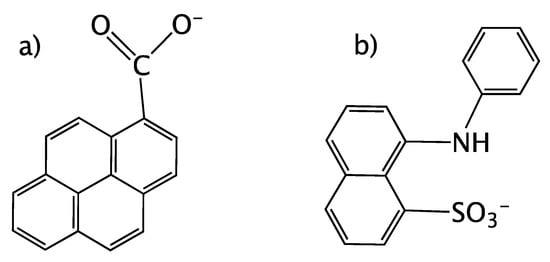
Figure 6.
Luminescent anions: (a) 1-pyrenecarboxylate and (b) 8-Anilino-1-naphthalene sulfonate, respectively.
ILs have been widely exploited for the pretreatment, processing, and preservation of lignocellulose materials [76,77], displaying, among other characteristics, effective antibacterial and antifungal activities and wettability properties.
Protic ionic liquids, based on the 1-ammonium-2-propanol cation and a series of carboxylates anions, have been recently proposed as “green” cleaner agents, as an alternative to thymol [78]. Schmitz et al. [79] observed that imidazolium ILs used in “paper de-acidification and reinforcement processes” have high similarity with well-known antimicotic agents such as Clotrimazole and Miconazole. For this reason, the authors investigated the antifungal capabilities of chloride and acetate imidazolium ILs against common paper molds and the permanence of ILs after the treatment. The results of this study were positive and, as the authors suggest, may represent the basis of future research aimed at obtaining simultaneous repair and protection against microorganisms in treated documents.
Regarding the application of ILs in stone restoration, very little has been done. An interesting example is represented by ILs based on the multifunctional polyoxametalated [α-SiW11O39]8- (POM) polyanion, a multifunctional class of metal cluster oxides never exploited in this frame. The two tetralkylammonium POM-ILs (Figure 7), namely [(n-C7H15)4N]8[α-SiW11O39] (1) and [(n-C6H13)3[(n-C14H29)N]8[α-SiW11O39] (2), respectively, have been investigated both as antimicrobial and anticorrosive stone coatings [80].

Figure 7.
Schematic representation of the two POM-ILs, namely [(n-C7H15)4N]8 [α-SiW11O39] (1) and [(n-C6H13)3[(n-C14H29)N]8[α-SiW11O39] (2), investigated both as antimicrobial and anticorrosive stone coatings.
Both 1 and 2 POM-ILs coatings proved very resistant to acid exposure. The degree of corrosion was dependent on stone features (> porosity = > damage), while the thickness of the coating was important to reduce the acidic corrosion. Their antimicrobial activity was tested by using Gram-positive strain (B. subtilis) and Gram-negative one (E. coli) as bacterial models [80]. The data obtained in vitro revealed a good activity for both POM-ILs against the two strains (particularly vs. B. subtilis) being better performing. They have also shown good antifouling activity on different stone substrates. However, as the same authors declared, the data needs further research, in that the tests were performed on strains not derived from stone, and over a short time (72 h).
Water wettability (absorbency/hydrophobicity) significantly contributes to the surface deterioration process of stone artifacts and buildings and also to biological colonization. ILs anion exchange constitutes a useful means to control the wettability of ILs based materials. Studies regarding a series of ammonium ILs species based on a variety of SA anions, both fluorinated and non-fluorinated, have shown that dodecylbenzenesulfonate (DBS) anion produced the most hydrophobic behavior [81,82]. These results prompted an investigation on the influence of surface-active anions on the antimicrobial activity of the IL series, named [QA][X], as reported by De Leo et al. [83] and in Figure 8.
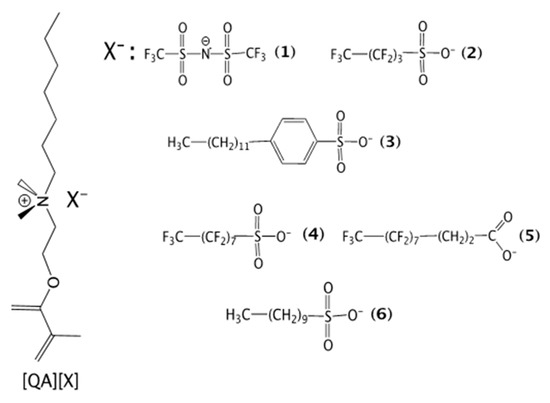
Figure 8.
Schematic representation of the [QA][X], 1-6, IL series. The IL numbering is the same used in the original paper [83].
The antimicrobial assessment of 1–6 was carried out on four microbial strains isolated from deteriorated monuments and compared with that of Preventol® 80 (CTS) (S1) and Rocima™ 103 (CTS) (S2) used as standards. The results obtained substantiate that lipophilicity of anions plays a pivotal role in determining the antimicrobial activities of these ILs, in that only the DBS derivative 3, and to some extent, the decanesulfonate one, 6, displayed significant bioactivity. In particular, the DBS based IL was remarkably active against the G (+) Micrococcus strain with an efficiency significantly higher than that of the two standards [83].
The interesting capabilities of DBS anion in inducing hydrophobic/lipophilic and antimicrobial properties as well, led to focused research on DBS based surface active anionic ionic liquids (SAAILs). Keeping in mind the mandatory principles of eco-sustainability, the selected cholinium cations (CH) were chosen as counterparts. The newly synthesized ILs include the heptyl and dodecyl [CH][DBS] derivatives, 2a and 3a, respectively, (Figure 9a) and the two germinal [CH]gem[DBS]2, 4a, and 5a, respectively (Figure 9b). The latter two differ in the connecting methylene chain length (at 6 and 8 C atoms, respectively). For comparison, the bioactivity of the CH halide precursors (2 and 3, respectively) has also been investigated. [De Leo et al. in prep.] The precursors 4 and 5 have not been considered because, in preliminary tests performed at different concentrations, they did not show any antimicrobial activity.

Figure 9.
Novel (a) mono- and (b) germinal cholinium DBS based ILs. IL numbering is the same used for the antimicrobial test shown in Figure 8 and in the manuscript [De Leo et al., in prep.].
The tests have been carried out on a mixed stabilized microbial suspension (Gram+ and Gram-, yeasts, hyphomycetes, and unicellular algae) on untreated (CP) stone probes (marble and calcarenite), treated with consolidant only (NanoEstel, NP) or treated with the consolidant and ILs, namely 2, 2a, 3, 3a, 4a, and 5a, respectively. As shown in Figure 10, after 90 days of incubation in laboratory conditions (22 °C and at a constant illumination of ca. 1500 Lux), different behavior of the tested ILs was observed. In fact, 2 and 2a, and, especially, 3 and 3a, showed interesting antimicrobial colonization capabilities. On the contrary, 4a and 5a, promoted a remarkable microbial growth, even more pronounced than the untreated control sample. Such findings corroborate, once more, that is the IL lipophilicility that determines their bioactivity in that 3 and 3a, featuring longer alkyl chain lengths on the CH cation resulted in the most effective ones.
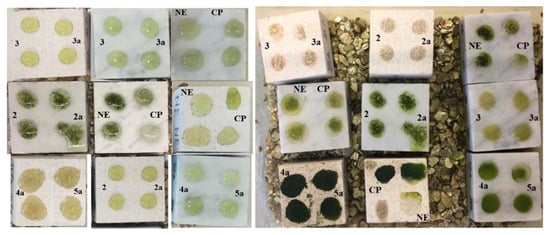
Figure 10.
Laboratory tests carried out with ILs showed in Figure 9 on stone probes. On the left, soon after the inoculation of 30 µL of mixed suspension (T0) and, on the right, after 90 days of incubation (T90). Tests were carried on marble and tupha probes in double and incubating at 22 °C and a constant illumination of ca. 1500 Lux [De Leo et al., in prep.].
A brief summary of the direct methods currently used or proposed as innovative ones is listed in Table 2.

Table 2.
Pros and cons of current direct methods and their functions.
9. Final Remarks
Innovation, nowadays, has become synonymous with ecosustainability, and that, in the CH field, is well summarized by the term “green conservation”. Starting with the acronym SMART (sustainability, management, risks, tools) from the “green conservation of cultural heritage” conference in 2019, comes the most all-inclusive term “green”. Its basics were applied to a critical review of recent results about preventing biodeterioration of stone materials. The conclusion is that chemical treatment for biocidal and antifouling actions is currently the most commonly used and most versatile means toward developing innovative solutions. Despite the interesting results obtained by using biotechnology and nanotechnology, surface-active QAC–based formulations, adopting new sustainable protocols, are being used the most.
Attention should be paid to IL technologies, although currently, there are few data. Tunable solvent properties and antimicrobial and surface activity are just some of the most interesting features of ILs. As reported in the literature, IL is an enabling technology to access to advanced materials, which can contribute to the production of new formulations of antifouling and antimicrobial surface coatings, developed as gel materials and other forms.
Interest in ILs, which exploded in the early 2000s, was mainly based on their green characteristics such as low volatility and recyclability. Over time, studies of their bioactivity and biodegradation caused their greenness to be significantly reconsidered. Research on the design of biodegradable ILs has significantly progressed, leading to the implementation of Safe by Design strategies for ionic liquids developments [58,60,61].
Author Contributions
Conceptualization, S.L.S. and C.U.; methodology, S.L.S., C.U., and F.D.L.; resources, S.L.S., C.U., and F.D.L; data curation, S.L.S., C.U., and F.D.L.; writing—original draft preparation, S.L.S. and C.U.; writing—review and editing, S.L.S., C.U., and F.D.L. All authors have read and agreed to the published version of the manuscript.
Funding
This research was partially funded by the financial contribution of FFABR 2017 and FFABR 2018 (Italian fund of basic research activities).
Acknowledgments
Authors would like to thank Andrea Macchia (Yococu, Youth in Conservation of Cultural Heritage), for his input and definition of SMART conservation and Sherron Collins for her revision of the English text.
Conflicts of Interest
The authors declare no conflict of interest.
References
- Pinna, D. Coping with Biological Growth on Stone Heritage Objects. Methods, Products, Applications, and Perspectives; Apple Academic Press: Oakville, ON, Canada, 2017; ISBN 9781771885324. [Google Scholar]
- Guillitte, O. Bioreceptivity: A new concept for building ecology studies. Sci. Total Environ. 1995, 167, 215–220. [Google Scholar] [CrossRef]
- UNI. Beni Culturali—Materiali Lapidei Naturali Ed Artificiali—Descrizione della Forma di Alterazione—Termini e Definizioni. Available online: http://store.uni.com/catalogo/uni-11182-2006/ (accessed on 26 June 2020).
- ICOMOS-ISCS. Illustrated Glossary on Stone Deterioration Patterns. Available online: http://iscs.icomos.org/glossary.html (accessed on 26 June 2020).
- Caneva, G.; Nugari, M.P.; Salvadori, O. Plant Biology for Cultural Heritage: Biodeterioration and Conservation; Getty Publications: Los Angeles, CA, USA, 2008; ISBN 978-0-89236-939-3. [Google Scholar]
- Commissione Normal. Raccomandazioni Normal: 38/93. Valutazione Sperimentale Dell’efficacia Dei Biocidi; C.N.R. I.C. R.: Rome, Italy, 1993. [Google Scholar]
- García-Castrillo, G.; Lanuza, P.; López, G. El entorno Marino de los Restos Arqueológicos. In La Conservación del Material Subacuático; Ayuntamiento de Santoña Monte Buciero Spain: Santoña, Spain, 2003; pp. 95–109, ISSN 1138-9680 9. [Google Scholar]
- Ruffolo, S.A.; Macchia, A.; La Russa, M.F.; Mazza, L.; Urzì, C.; De Leo, F.; Barberio, M.; Crisci, G.M. Marine antifouling for underwater archaeological sites: TiO2 and Ag-Doped TiO2. Int. J. Photoenergy 2013, 2013, 251647. [Google Scholar] [CrossRef] [PubMed]
- Camara, B.; Alvarez de Buergo, M.; Bethencourt, M.; Fernandez-Montblanc, T.; La Russa, M.F.; Ricca, M.; Fort, R. Biodeterioration of marble in underwater environment. Sci. Total Environ. 2017, 609, 109–122. [Google Scholar] [CrossRef]
- Bruno, L.; Valle, V. Effect of white and monochromatic lights on cyanobacteria and biofilms from Roman Catacombs. Int. Biodeter. Biodegr. 2017, 123, 286–295. [Google Scholar] [CrossRef]
- Krakova, L.; De Leo, F.; Bruno, L.; Pangallo, D.; Urzì, C. Complex bacterial diversity in the white biofilms of the Catacombs of St. Callixtus in Rome evidenced by different investigation strategies. Environ. Microbiol. 2015, 17, 1738–1752. [Google Scholar] [CrossRef]
- Van Der Molen, J.M.; Garty, J.; Aardema, B.W.; Krumbein, W.E. Growth control of algae and cyanobacteria on historical monuments by a mobile UV unit (MUVU). Stud. Conserv. 1980, 25, 71–77. [Google Scholar] [CrossRef]
- Borderie, F.; Alaoui–Sossé, B.; Aleya, L. Heritage materials and biofouling mitigation through UV–C irradiation in show caves: State of the art practices and future challenges. Environ. Sci. Pollut. Res. 2014, 6, 4144–4172. [Google Scholar] [CrossRef]
- Baquedano Estévez, C.; Moreno Merino, L.; de la Losa Román, A.; Durán Valsero, J.J. The lampenflora in show caves and its treatment: An emerging ecological problem. Int. J. Speleol. 2019, 48, 249–277. [Google Scholar] [CrossRef]
- Pfendler, S.; Einhorn, O.; Karimi, B.; Bousta, F.; Cailhol, D.; Alaoui-Sosse, L.; Alaoui-Sosse, B.; Aleya, L. UV-C as an efficient means to combat biofilm formation in show caves: Evidence from the La Glacière Cave (France) and laboratory experiments. Environ. Sci. Pollut. Res. 2017, 24, 24611–24623. [Google Scholar] [CrossRef]
- Tretiach, M.; Bertuzzi, S.; Candotto Carniel, F. Heat shock treatments: A new safe approach against lichen growth on outdoor stone surfaces. Environ. Sci. Technol. 2012, 46, 6851–6859. [Google Scholar] [CrossRef]
- Riminesi, C.; Olmi, R. Localized microwave heating for controlling biodeteriogens on cultural heritage assets. Int. J. Conserv. Sci. 2016, 7, 281–294. [Google Scholar]
- Bertuzzi, S.; Candotto Carniel, F.; Pipan, G.; Tretiach, M. Devitalization of poikilohydric lithobionts of open-air monuments by heat shock treatments: A new case study centred on bryophytes, Int. Biodeter. Biodegr. 2013, 84, 44–53. [Google Scholar] [CrossRef]
- Mascalchi, M.; Orsini, C.; Pinna, D.; Salvadori, B.; Siano, S.; Riminesi, C. Assessment of different methods for the removal of biofilms and lichens on gravestones of the English cemetery in Florence. Int. Biodeter. Biodegr. 2020, in press. [Google Scholar] [CrossRef]
- Allsopp, C.; Allsopp, D. An updated survey of commercial products used to protect materials against biodeterioration. Int. Biodeterior. Biodegrad. 1983, 19, 99–146. [Google Scholar] [CrossRef]
- AA.VV. Regulation (EU) No 528/2012 of the European Parliament and of the Council of 22 May 2012 Concerning the Making Available on the Market and Use of Biocidal Products. 2012. Available online: http://data.europa.eu/eli/reg/2012/528/2019-11-20 (accessed on 18 September 2020).
- Yebra, D.M.; Kiil, S.; Johansen, K.D. Antifouling technology-past, present and future steps toward efficient and environmentally friendly antifouling coatings. Progr. Org. Coat. 2004, 50, 75–104. [Google Scholar] [CrossRef]
- Delgado Rodrigues, J.; Vale Anjos, M.; Charola, A.E. Recolonization of Marble Sculptures in a Garden Environment. In Biocolonization of Stone: Control and Preventive Methods; Charola, A.E., McNamara, C., Koestler, R.J., Eds.; Smithsonian, Contributions to Museum Conservation; Smithsonian Institution Scholarly Press: Washington, DC, USA, 2011; pp. 71–85. [Google Scholar]
- Urzì, C.; De Leo, F. Evaluation of the efficiency of water-repellent and biocide compounds against microbial colonization of mortars. Int. Biodeter. Biodegr. 2007, 60, 25–34. [Google Scholar] [CrossRef]
- Pinna, D.; Salvadori, B.; Galeotti, M. Monitoring the performance of innovative and traditional biocides mixed with consolidants and water-repellents for the prevention of biological growth on stone. Sci. Total Environ. 2012, 423, 132–141. [Google Scholar] [CrossRef]
- Liu, X.; Liang, Y.; Zhou, F.; Liu, W. Extreme wettability and tunable adhesion: Biomimicking beyond nature? Soft Matter 2012, 8, 2070–2086. [Google Scholar] [CrossRef]
- Parkin, I.P.; Palgrave, R.G. Self-cleaning coatings. J. Mater. Chem. 2005, 15, 1689–1695. [Google Scholar] [CrossRef]
- Zarzuela, R.; Moreno-Garrido, I.; Blasco, J.; Gil, M.L.A.; Mosquera, M.J. Evaluation of the effectiveness of CuONPs/SiO2-based treatments for building stones against the growth of phototrophic microorganisms. Construct. Build. Mater. 2018, 187, 501–509. [Google Scholar] [CrossRef]
- La Russa, M.F.; Macchia, A.; Ruffolo, S.A.; De Leo, F.; Barberio, M.; Barone, P.; Crisci, G.M.; Urzì, C. Testing the antibacterial activity of doped TiO2 for preventing biodeterioration of Cultural Heritage building materials. Int. Biodeter. Biodegr. 2014, 96, 87–96. [Google Scholar] [CrossRef]
- Artesani, A.; Di Turo, F.; Zucchelli, M.; Traviglia, A. Recent Advances in Protective Coatings for Cultural Heritage–An Overview. Coatings 2020, 10, 217. [Google Scholar] [CrossRef]
- Zarzuela, R.; Luna, M.; Carrascosa, L.A.; Mosquera, M.J. Preserving Cultural Heritage Stone: Innovative Consolidant, Superhydrophobic, Self-Cleaning, and Biocidal Products. In Advanced Materials for the Conservation of Stone; Hosseini, M., Karapanagiotis, I., Eds.; Springer: Chan, Switzerland, 2018; pp. 259–275. [Google Scholar] [CrossRef]
- Lejars, M.; Margaillan, A.M.; Bressy, C. Fouling release coatings: A nontoxic alternative to biocidal antifouling coatings. Chem. Rev. 2012, 112, 4347–4390. [Google Scholar] [CrossRef]
- Palla, F.; Bruno, M.; Mercurio, F.; Tantillo, A.; Rotolo, V. Essential Oils as Natural Biocides in Conservation of Cultural Heritage. Molecules 2020, 25, 730. [Google Scholar] [CrossRef] [PubMed]
- Bruno, L.; Rugnini, L.; Spizzichino, V.; Caneve, L.; Canini, A.; Ellwood, N.T.W. Biodeterioration of Roman hypogea: The case study of the Catacombs of SS. Marcellino and Pietro (Rome, Italy). Ann. Microbiol. 2019, 69, 1023–1032. [Google Scholar] [CrossRef]
- Silva, M.; Rosado, T.; Teixeira, D.; Candeias, A.; Caldeira, A.T. Green mitigation strategy for Cultural Heritage: Bacterial potential for biocide production. Environ. Sci. Pollut. Res. 2017, 24, 4871–4881. [Google Scholar] [CrossRef]
- Jurado, V.; del Rosal, Y.; Gonzalez-Pimentel, J.L.; Hermosin, B.; Saiz-Jimenez, C. Biological control of phototrophic biofilms in a show cave: The case of Nerja Cave. Appl. Sci. 2020, 10, 3448. [Google Scholar] [CrossRef]
- Veneranda, M.; Blanco-Zubiaguirre, L.; Roselli, G.; Di Girolami, G.; Castro, K.A.; Madariaga, J.M. Evaluating the exploitability of several essential oils constituents as a novel biological treatment against cultural heritage biocolonization. Microchem. J. 2018, 138, 1–6. [Google Scholar] [CrossRef]
- ECHA. Guidance on the Biocidal Products Regulation: Volume V-Guidance on Active Microorganisms and Biocidal Products; European Chemicals Agency: Helsinki, Finland, 2017. [Google Scholar] [CrossRef]
- Fidanza, M.R.; Caneva, G. Natural biocides for the conservation of stone cultural heritage: A review. J. Cult. Herit. 2019, 38, 271–286. [Google Scholar] [CrossRef]
- Bartolini, M.; Pietrini, A.M.; Ricci, S. Valutazione dell’efficacia di alcuni nuovi biocidi per il trattamento di microflora fotosintetica e di briofite su materiali lapidei. Boll. ICR 2007, 14, 101–111. [Google Scholar]
- Ruffolo, S.A.; De Leo, F.; Ricca, M.; Arcudi, A.; Silvestri, C.; Bruno, L.; Urzì, C.; La Russa, M.F. Medium-term in situ experiment by using organic biocides and titanium dioxide for the mitigation of microbial colonization on stone surfaces. Int. Biodeter. Biodegr. 2017, 123, 17–26. [Google Scholar] [CrossRef]
- Anastas, P.T.; Warner, J.C. Green Chemistry: Theory and Practice; Oxford University Press: New York, NY, USA, 1998. [Google Scholar]
- Baglioni, P.; Carretti, E.; Chelazzi, D. Nanomaterials in art conservation. Nat. Nanotechnol. 2015, 10, 287–290. [Google Scholar] [CrossRef] [PubMed]
- Sierra-Fernández, A.; Gómez-Villalba, L.S.; Rabanal, M.E.; Fort, R. New nanomaterials for applications in conservation and restoration of stony materials: A review. Mater. Construct. 2017, 67, e107. [Google Scholar] [CrossRef]
- Toniolo, L.; Gherardi, F. The Protection of Marble Surfaces: The Challenge to Develop Suitable Nanostructured Treatments. In Advanced Materials for the Conservation of Stone; Hosseini, M., Karapanagiotis, I., Eds.; Springer: Cham, Switzerland, 2018; pp. 57–78. [Google Scholar] [CrossRef]
- Ruffolo, S.A.; La Russa, M.F. Nanostructured Coatings for Stone Protection: An Overview. Front. Mater. 2019, 6, 147. [Google Scholar] [CrossRef]
- Manoudis, P.N.; Karapanagiotis, I.; Tsakalof, A.; Zuburtikudis, I.; Kolinkeovà, B.; Panayiotou, C. Superhydrophobic films for the protection of outdoor cultural heritage assets. Appl. Phys. A 2009, 97, 351–360. [Google Scholar] [CrossRef]
- Pinho, L.; Mosquera, M.J. Titania-silica nanocomposite photocatalysts with application in stone self-cleaning. J. Phys. Chem. C 2011, 115, 22851–22862. [Google Scholar] [CrossRef]
- Martines, E.; Seunarine, K.; Morgan, H.; Gadegaard, N.; Wilkinson, C.D.W.; Riehle, M.O. Superhydrophobicity and superhydrophilicity of regular nanopatterns. Nano Lett. 2005, 5, 2097–2103. [Google Scholar] [CrossRef]
- Reyes-Estebanez, M.; Ortega-Morales, B.O.; Chan-Bacab, M.; Granados-Echegoyen, C.; Camacho-Chab, J.C.; Pereañez-Sacarias, J.E.; Gaylarde, C. Antimicrobial engineered nanoparticles in the built cultural heritage context and their ecotoxicological impact on animals and plants: A brief review. Herit. Sci. 2018, 6, 52. [Google Scholar] [CrossRef]
- Semenzin, E.; Giubilato, E.; Badetti, E.; Picone, M.; Volpi Ghirardini, A.; Hristozov, D.; Brunelli, A.; Marcomini, A. Guiding the development of sustainable nano-enabled products for the conservation of works of art: Proposal for a framework implementing the safe by design concept. Environ. Sci. Pollut. Res. 2019, 26, 26146–26158. [Google Scholar] [CrossRef]
- Plechkova, N.V.; Seddon, K.R. Applications of ionic liquids in the chemical industry. Chem. Soc. Rev. 2008, 37, 123–150. [Google Scholar] [CrossRef]
- Welton, T. Ionic liquids: A brief history. Biophys. Rev. 2008, 10, 691–706. [Google Scholar] [CrossRef] [PubMed]
- Eftekhari, A. Lonic Liquid Devices. Royal Society of Chemistry. 2018. Available online: https://pubs.rsc.org/en/content/ebook/978-1-78801-183-9 (accessed on 18 September 2020).
- Mecerreyes, D. Polymeric ionic liquids: Broadening the properties and applications of polyelectrolytes. Prog. Polym. Sci. 2011, 36, 1629–1648. [Google Scholar] [CrossRef]
- Xin, B.; Hao, J. Imidazolium-based ionic liquids grafted on solid surfaces. Chem. Soc. Rev. 2014, 43, 7171. [Google Scholar] [CrossRef] [PubMed]
- Cardiano, P.; Fazio, E.; Lazzara, G.; Manickam, S.; Milioto, S.; Neri, F.; Mineo, P.G.; Piperno, A.; Lo Schiavo, S. Highly untangled multiwalled carbon nanotube@polyhedral oligomeric silsesquioxane ionic hybrids: Synthesis, characterization and nonlinear optical properties. Carbon 2015, 86, 325–337. [Google Scholar] [CrossRef]
- Jordan, A.; Gathergood, N. Biodegradation of ionic liquids—A critical review. Chem. Soc. Rev. 2015, 44, 8200–8237. [Google Scholar] [CrossRef]
- Ferraz, R.; Branco, L.C.; Prudencio, C.; Noronha, J.P.; Petrovski, Z. Ionic Liquids as active pharmaceutical ingredients. ChemMedChem 2011, 6, 975–985; [Google Scholar] [CrossRef]
- Petkovic, M.; Seddon, K.R.; Rebelo, L.P.N.; Pereira, C.S. Ionic liquids: A pathway to environmental acceptability. Chem. Soc. Rev. 2011, 40, 1383–1403. [Google Scholar] [CrossRef]
- Santos, J.I.; Gonçalves, A.M.M.; Pereira, J.L.; Figueiredo, B.F.H.T.; Silva, F.A.; Coutinho, J.A.P.; Ventura, S.P.M.; Gonçalves, F. Environmental safety of cholinium-based ionic liquids: Assessing structure–ecotoxicity relationships. Green Chem. 2015, 17, 4657–4668. [Google Scholar] [CrossRef]
- Marr, P.C.; Marr, A.C. Ionic liquid gel materials: Applications in green and sustainable chemistry. Green Chem. 2016, 18, 105. [Google Scholar] [CrossRef]
- Brogan, A.P.S.; Clarke, C.J.; Charalambidou, A.; Loynachan, C.N.; Norman, S.E.; Doutche, J.; Hallet, J.P. Expanding the design space of gel materials through ionic liquid mediated mechanical and structural tuneability. Mater. Horiz. 2020, 7, 820–826. [Google Scholar] [CrossRef]
- Pendleton, J.N.; Gilmore, B.F. The antimicrobial potential of ionic liquids: A source of chemical diversity for infection and biofilm control. Int. J. Antimicrob. Agents 2015, 46, 131–139. [Google Scholar] [CrossRef] [PubMed]
- Egorova, K.S.; Gordeev, E.G.; Ananikov, V.P. Biological Activity of Ionic Liquids and Their Application in pharmaceutics and medicine. Chem. Rev. 2017, 117, 7132–7189. [Google Scholar] [CrossRef] [PubMed]
- Sintra, T.E.; Vilas, M.; Martins, M.; Ventura, S.P.M.; Lobo Ferreira, A.I.M.C.; Santos, L.M.N.B.F.; Fernando, J.M.; Tojo, G.E.; Coutinho, J.A.P. Synthesis and characterization of surface-active Ionic Liquids used in the disruption of Escherichia coli cells. ChemPhysChem 2019, 20, 727–735. [Google Scholar] [CrossRef]
- Benedetto, A.; Ballone, P. Room temperature Ionic Liquids Meet Biomolecules: A microscopic view of structure and dynamics. ACS Sustain. Chem. Eng. 2016, 4, 392–412. [Google Scholar] [CrossRef]
- Benedetto, A.; Ballone, P. Room-Temperature Ionic Liquids and biomembranes: Setting the stage for applications in pharmacology, biomedicine, and bionanotechnology. Langmuir 2018, 34, 9579–9597. [Google Scholar] [CrossRef]
- Guo, J.; Xu, Q.; Zheng, Z.; Zhou, S.; Hailei, M.H.; Wang, B.; Yan, F. Intrinsically antibacterial poly(ionic liquid) membranes: The synergistic effect of anions. ACS Macro Lett. 2015, 4, 1094–1098. [Google Scholar] [CrossRef]
- Ye, Q.; Tingting Gao, T.; Wan, F.; Yu, B.; Pei, X.; Zhou, F.; Xue, Q. Grafting poly(ionic liquid) brushes for anti-bacterial and anti-biofouling applications. J. Mater. Chem. 2012, 22, 13123–13131. [Google Scholar] [CrossRef]
- Jin, L.; Shi, Z.; Zhang, X.; Liu, X.; Li, H.; Wang, J.; Liang, F.; Zhao, W.; Zhao, C. Intelligent antibacterial surface based on ionic liquid molecular brushes for bacterial killing and release. J. Mater. Chem. 2019, 7, 5520–5527. [Google Scholar] [CrossRef]
- Su-Yun, Z.; Zhuang, Q.; Zhang, M.; Wang, H.; Gao, Z.; Jian-Ke, S.J.; Jiayin, Y. Poly(ionic liquid) composites. Chem. Soc. Rev. 2020, 49, 1726–1755. [Google Scholar] [CrossRef]
- Machado, A.S.; Redol, P.; Branco, L.; Vilarigues, M. Ionic Liquids for Medieval Stained-Glass Cleaning: A New Frontier. In Proceedings of the ICOM-CC Lisbon. Portugal: 16th Triennal Conference, Lisbon, Portugal, 19–23 September 2011. [Google Scholar]
- Pacheco, M.F.; Pereira, A.I.; Branco, L.C.; Parola, A.J. Varnish removal from paintings using ionic liquids. J. Mater. Chem. A 2013, 1, 7016–7018. [Google Scholar] [CrossRef]
- Delgado, J.M.; Nunes, D.; Fortunato, E.; Laia, C.A.T.; Branco, L.C.; Vilarigues, M. The effect of three luminescent ionic liquids on corroded glass surfaces—A first step into stained-glass cleaning. Corros. Sci. 2017, 118, 109–117. [Google Scholar] [CrossRef]
- Przybysz, K.; Drzewinńska, E.; Stanisławska, A.; Wysocka-Robak, A.; Cieniecka-Rosłonkiewicz, A.; Foksowicz-Flaczyk, J.; Pernak, J. Ionic Liquids and paper. Ind. Eng. Chem. Res. 2005, 44, 4599–4604. [Google Scholar] [CrossRef]
- Abushammala, H.; Mao, J. A review on the partial and complete dissolution and fractionation of wood and lignocelluloses using imidazolium Ionic Liquids. Polymers 2020, 12, 195. [Google Scholar] [CrossRef]
- Dimitric, N.; Spremo, N.; Vraneš, M.; Belić, S.; Karaman, M.; Kovačević, S.; Karadžić, M.; Podunavac-Kuzmanović, S.; Crkvenjakovc, D.K.; Slobodan Gadžurić, S. New protic ionic liquids for fungi and bacteria removal from paper heritage. RSC Adv. 2019, 9, 17905–17912. [Google Scholar] [CrossRef]
- Schmitz, K.; Wagner, S.; Reppke, M.; Maier, C.L.; Windeisen-Holzhauser, E.; Benz, J.P. Preserving cultural heritage: Analyzing the antifungal potential of ionic liquids tested in paper restoration. PLoS ONE 2019, 14, e0219650. [Google Scholar] [CrossRef]
- Archismita, M.; Castillo, I.F.; Müller, D.P.; Gonzμlez, C.; Eyssautier-Chuine, S.; Ziegler, A.; de la Fuente, J.M.; Mitchell, S.G.; Streb, C. Polyoxometalate-Ionic Liquids (POM-ILs) as anticorrosion and antibacterial coatings for natural stones. Angew. Chem. Int. Edit. 2018, 57, 14926–14931. [Google Scholar] [CrossRef]
- Cardiano, P.; Mineo, P.G.; Neri, F.; Lo Schiavo, S.; Piraino, P. A new application of ionic liquids: Hydrophobic properties of tetraalkylammonium based poly(ionic liquid)s. J. Mater. Chem. 2008, 18, 1253–1260. [Google Scholar] [CrossRef]
- Mineo, P.G.; Livoti, L.; Giannetto, M.; Gulino, A.; Lo Schiavo, S.; Cardiano, P. Very fast CO2 response and hydrophobic properties of novel poly(ionic-liquid)s. J. Mater. Chem. 2009, 19, 8861–8870. [Google Scholar] [CrossRef]
- De Leo, F.; Cardiano, P.; De Carlo, G.; Lo Schiavo, S.; Urzì, C. Testing the antimicrobial properties of an upcoming “environmental-friendly” family of ionic liquids. J. Mol. Liq. 2017, 248, 81–85. [Google Scholar] [CrossRef]
© 2020 by the authors. Licensee MDPI, Basel, Switzerland. This article is an open access article distributed under the terms and conditions of the Creative Commons Attribution (CC BY) license (http://creativecommons.org/licenses/by/4.0/).